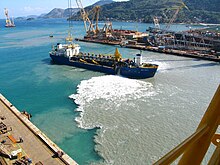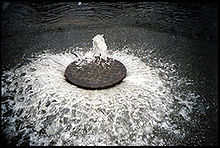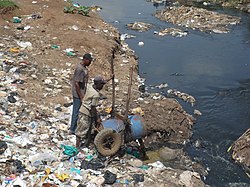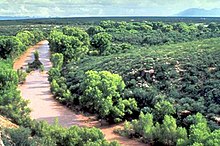
HI FRIENDS.I HAVE BEEN MEETING U AFTER A LONG TIME.I AM LITTLE BIT BUSY WITH MY ANNUAL PREPARATIONS AND NOW I HAVE CLEARED THEM VERY WELL.
NOW I WANT TO SHARE MY VIEWS ON WATER POLLUTION.AND I WANT TO LET U KNOW ABOUT THE WATER RESOURCES AND HOW THEY ARE SPOILED BY THIS HUMAN ACTIVITIES.
A graphical distribution of the locations of water on Earth. Only 3% of the Earth's water is fresh water. Most of it is in icecaps and glaciers (69%) and groundwater (30%), while all lakes, rivers and swamps combined only account for a small fraction (0.3%) of the Earth's total freshwater
reserves.
water resources are sources of water that are potentially useful. The majority of human uses
require fresh water.
97% of the water on the Earth is salt water and only three percent is fresh water, slightly over two thirds of this is frozen in glaciers and polar ice caps.The remaining unfrozen freshwater is found mainly as groundwater, with only a small fraction present above ground or in the air.
Fresh water is a renewable resource, yet the world's supply of ground water is steadily decreasing, with depletion occurring most prominently in Asia, South America and North America, although it is still unclear how much natural renewal balances this usage, and whether ecosystems are threatened. The framework for allocating water resources to water users (where such a framework exists) is known as water rights.
Surface water
Surface water is water in a river,lake or fresh water wet land. Surface water is naturally replenished by precipitation and naturally lost through discharge to the oceans,evaporation,evapotranspiration and ground water recharge.
Although the only natural input to any surface water system is precipitation within its watershed, the total quantity of water in that system at any given time is also dependent on many other factors. These factors include storage capacity in lakes, wetlands and artificial reservoirs, the permeability of the soil beneath these storage bodies, the runoff characteristics of the land in the watershed, the timing of the precipitation and local evaporation rates. All of these factors also affect the proportions of water loss.
Human activities can have a large and sometimes devastating impact on these factors. Humans often increase storage capacity by constructing reservoirs and decrease it by draining wetlands. Humans often increase runoff quantities and velocities by paving areas and channelizing the stream flow.
The total quantity of water available at any given time is an important consideration. Some human water users have an intermittent need for water. For example, many farms require large quantities of water in the spring, and no water at all in the winter. To supply such a farm with water, a surface water system may require a large storage capacity to collect water throughout the year and release it in a short period of time. Other users have a continuous need for water, such as a power plant that requires water for cooling. To supply such a power plant with water, a surface water system only needs enough storage capacity to fill in when average stream flow is below the power plant's need.
Nevertheless, over the long term the average rate of precipitation within a watershed is the upper bound for average consumption of natural surface water from that watershed.
Natural surface water can be augmented by importing surface water from another watershed through a canal or pipeline. It can also be artificially augmented from any of the other sources listed here, however in practice the quantities are negligible. Humans can also cause surface water to be "lost" (i.e. become unusable) through pollution.
Brazil is the country estimated to have the largest supply of fresh water in the world, followed by Russia and Canada.
HOW THIS WATER IS BEING POLLUTED?
Water pollution is the contamination of water bodies (e.g. lakes, rivers, oceans, aquifers and groundwater). This form of environmental degradation occurs when pollutants are directly or indirectly discharged into water bodies without adequate treatment to remove harmful compounds.
Water pollution affects the entire biosphere – plants and organisms living in these bodies of water. In almost all cases the effect is damaging not only to individual species and population, but also to the natural biological communities
.
Water pollution is a major global problem which requires ongoing evaluation and revision of water resource policy at all levels (international down to individual aquifers and wells). It has been suggested that water pollution is the leading worldwide cause of deaths and diseases,[1][2] and that it accounts for the deaths of more than 14,000 people daily.[2] An estimated 580 people in India die of water pollution related illness every day.[3] About 90 percent of the water in the cities of China is polluted.[4] As of 2007, half a billion Chinese had no access to safe drinking water.[5] In addition to the acute problems of water pollution in developing countries, developed countries also continue to struggle with pollution problems. For example, in the most recent national report on water quality in the United States, 44 percent of assessed stream miles, 64 percent of assessed lake acres, and 30 percent of assessed bays and estuarine square miles were classified as polluted.[6] The head of China's national development agency said in 2007 that one quarter the length of China's seven main rivers were so poisoned the water harmed the skin.[7]
Water is typically referred to as polluted when it is impaired by anthropogenic contaminants and either does not support a human use, such as drinking water, or undergoes a marked shift in its ability to support its constituent biotic communities, such as fish. Natural phenomena such as volcanoes, algae blooms, storms, and earthquakes also cause major changes in water quality and the ecological status of water.Although interrelated, surface water and groundwater have often been studied and managed as separate resources.[8] Surface water seeps through the soil and becomes groundwater. Conversely, groundwater can also feed surface water sources. Sources of surface water pollution are generally grouped into two categories based on their origin.
Point source water pollution refers to contaminants that enter a waterway from a single, identifiable source, such as a pipe orditch. Examples of sources in this category include discharges from a sewage treatment plant, a factory, or a city storm drain. The U.S. Clean Water Act (CWA) defines point source for regulatory enforcement purposes.[9] The CWA definition of point source was amended in 1987 to include municipal storm sewer systems, as well as industrial storm water, such as from construction sites.[10]
Non-point sources
Nonpoint source pollution refers to diffuse contamination that does not originate from a single discrete source. NPS pollution is often the cumulative effect of small amounts of contaminants gathered from a large area. A common example is the leaching out of nitrogen compounds from fertilized agricultural lands.[11] Nutrient runoff in storm water from "sheet flow" over an agricultural field or a forest are also cited as examples of NPS pollutionContaminated storm water washed off of parking lots, roads and highways, called urban runoff, is sometimes included under the category of NPS pollution. However, because this runoff is typically channeled into storm drain systems and discharged through pipes to local surface waters, it becomes a point source.
Groundwater pollution
Interactions between groundwater and surface water are complex. Consequently, groundwater pollution, also referred to as groundwater contamination, is not as easily classified as surface water pollution.[8] By its very nature, groundwater aquifersare susceptible to contamination from sources that may not directly affect surface water bodies, and the distinction of point vs. non-point source may be irrelevant. A spill or ongoing release of chemical or radionuclide contaminants into soil (located away from a surface water body) may not create point or non-point source pollution but can contaminate the aquifer below, creating a toxic plume. The movement of the plume, called a plume front, may be analyzed through a hydrological transport model or groundwater model. Analysis of groundwater contamination may focus on soil characteristics and site geology,hydrogeology, hydrology, and the nature of the contaminants.
The specific contaminants leading to pollution in water include a wide spectrum of chemicals, pathogens, and physical changes such as elevated temperature and discoloration. While many of the chemicals and substances that are regulated may be naturally occurring (calcium, sodium, iron, manganese, etc.) the concentrationis often the key in determining what is a natural component of water and what is a contaminant. High concentrations of naturally occurring substances can have negative impacts on aquatic flora and fauna.
Oxygen-depleting substances may be natural materials such as plant matter (e.g. leaves and grass) as well as man-made chemicals. Other natural and anthropogenic substances may cause turbidity (cloudiness) which blocks light and disrupts plant growth, and clogs the gills of some fish species.[12]
Many of the chemical substances are toxic. Pathogens can produce waterborne diseases in either human or animal hosts.[13] Alteration of water's physical chemistry includes acidity (change in pH), electrical conductivity, temperature, and eutrophication. Eutrophication is an increase in the concentration of chemical nutrients in an ecosystem to an extent that increases the primary productivity of the ecosystem. Depending on the degree of eutrophication, subsequent negative environmental effects such as anoxia (oxygen depletion) and severe reductions in water quality may occur, affecting fish and other animal populations.
Pathogens
Disease-causing microorganisms are referred to as pathogens. Although the vast majority of bacteria are either harmless or beneficial, a few pathogenic bacteria can cause disease. Coliform bacteria, which are not an actual cause of disease, are commonly used as a bacterial indicator of water pollution. Other microorganisms sometimes found in surface waters that have caused human health problems include:
- Burkholderia pseudomallei
- Cryptosporidium parvum
- Giardia lamblia
- Salmonella
- Norovirus and other viruses
- Parasitic worms including the Schistosoma type [14][15]
High levels of pathogens may result from on-site sanitation systems (septic tanks, pit latrines) or inadequately treatedsewage discharges.[16] This can be caused by a sewage plant designed with less than secondary treatment (more typical in less-developed countries). In developed countries, older cities with aging infrastructure may have leaky sewage collection systems (pipes, pumps, valves), which can cause sanitary sewer overflows. Some cities also have combined sewers, which may discharge untreated sewage during rain storms.[17]
Pathogen discharges may also be caused by poorly managed livestock operations.
w
a
t
e
r
P
o
l
l
u
t
i
o
n
SO FRIENDS I HOPE U REALIZED HOW WATER IS POLLUTED. TRY TO STOP WATER POLLUTION.
-------------------------THANK YOU-------------------------------------
YOU ARE WELCOME FOR ANY SUGGESTIONS AND CORRECTIONS.
FOLLOW ME AT








